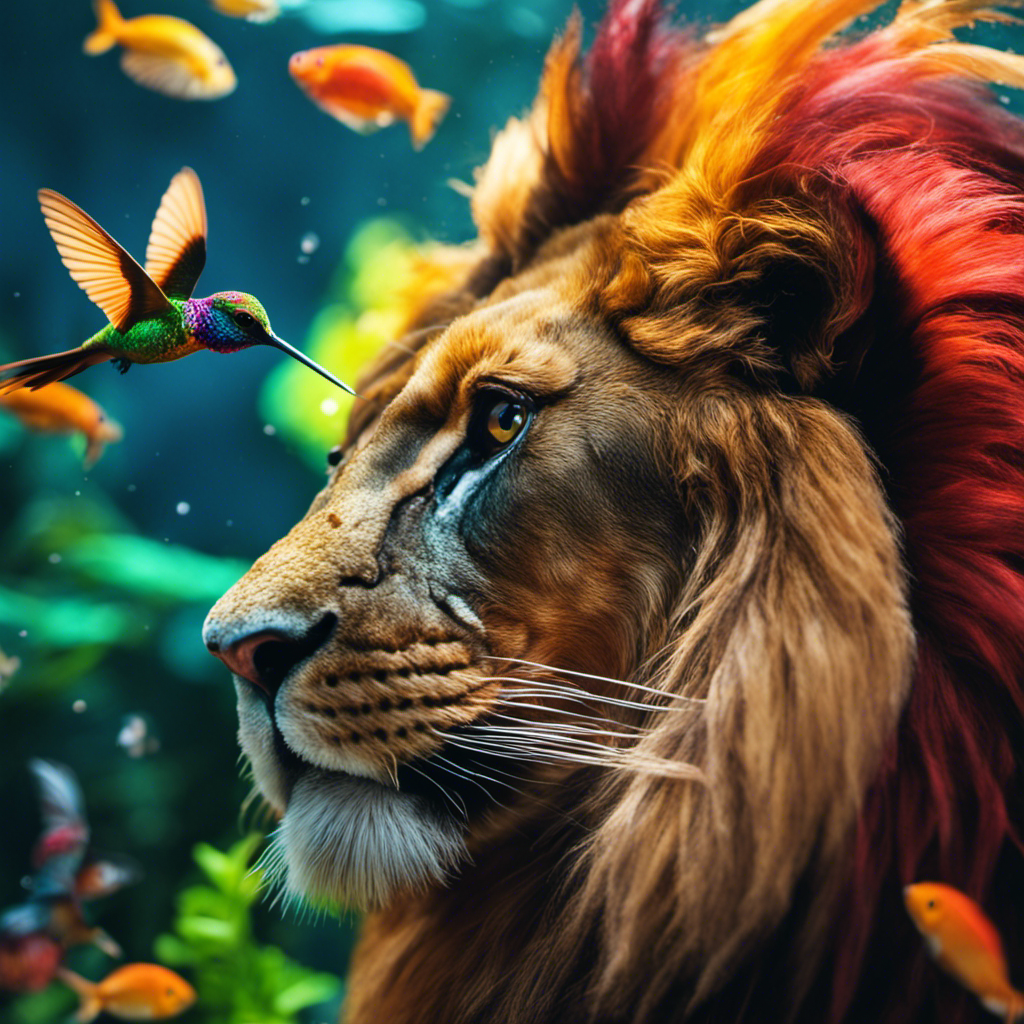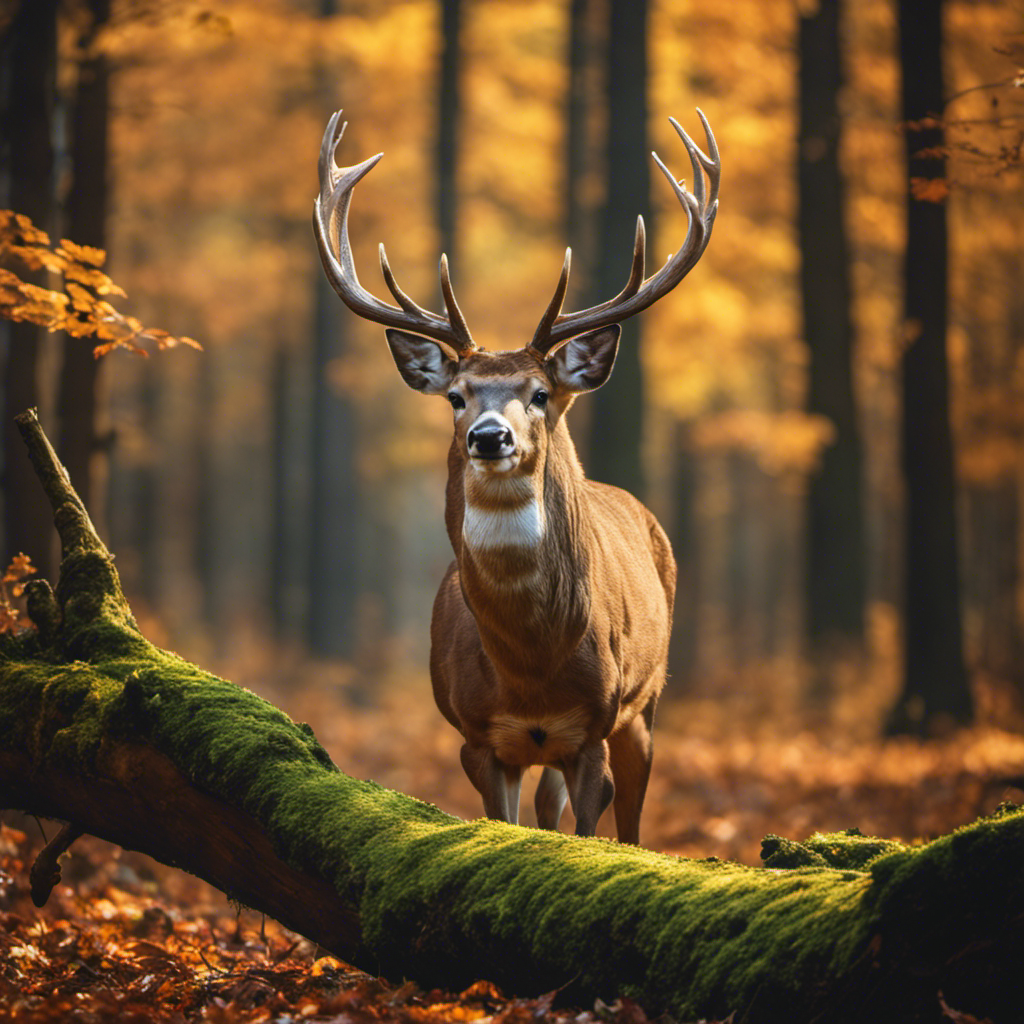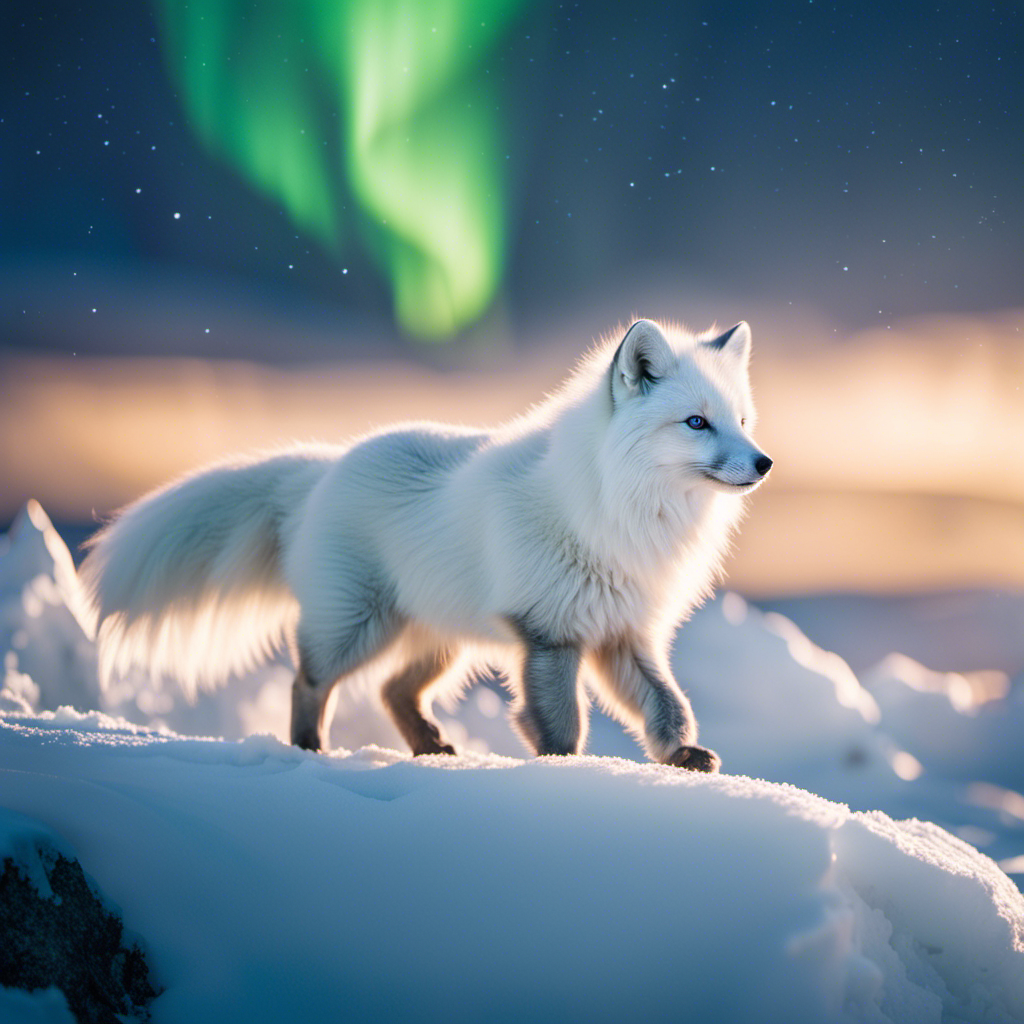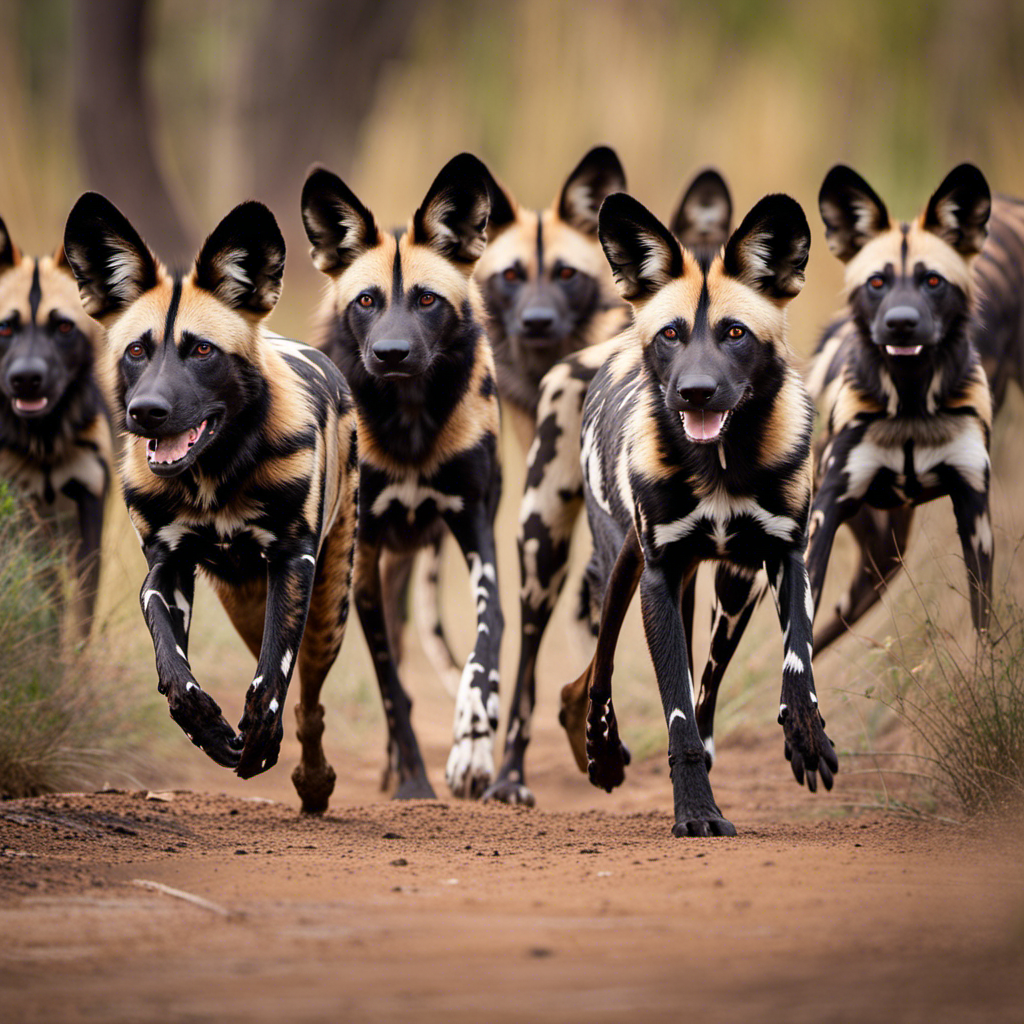Are you ready to explore the fascinating world of the animal kingdom? Get ready for a wild adventure as we dive into some mind-blowing fun facts!
From the largest land animal to the fastest swimmer, there’s so much to discover. You’ll be amazed by the intelligence of some creatures and stunned by the incredible journeys they undertake.
Prepare to be wowed with colorful birds, high-flying champions, and even record-breaking lifespans.
Join us on this thrilling journey through the animal kingdom where knowledge and belonging await you!
Key Takeaways
- The cheetah is the fastest land animal, reaching speeds of up to 70 miles per hour.
- Dolphins are highly intelligent creatures with exceptional problem-solving skills and communication techniques.
- The bumblebee bat has adaptations for navigating narrow cave passages and feeding on nectar.
- The immortal jellyfish can revert its cells back to their juvenile stage, making it the longest living creature.
Largest Land Animal
Did you know that the African elephant is the largest land animal on Earth? These magnificent creatures hold the title for being the largest mammals and heaviest land animals.
With their immense size and strength, they command respect from all who encounter them. Adult male elephants can reach heights of up to 13 feet at the shoulder and weigh an astonishing 12,000 pounds or more. Their sheer presence is awe-inspiring, instilling a sense of wonder and admiration in those fortunate enough to witness them in their natural habitat.
The African elephant’s massive tusks, curved trunks, and distinctive ears make them easily recognizable among other species. Being part of a social hierarchy within their herds gives these majestic animals a strong sense of belonging and community.
Fastest Land Animal
When it comes to speed, few animals can match the cheetah. With incredible acceleration and agility, this majestic feline is known for its ability to sprint across the savannah in a heartbeat.
Its lightning-fast bursts of speed allow it to reach impressive velocities and cover long distances in a matter of seconds.
Get ready to be amazed by the cheetah’s remarkable skills as we delve into the world of the fastest land animal.
Cheetah’s Incredible Speed
The cheetah’s incredible speed makes it the fastest land animal in the world. Unlike human sprinters who can maintain their top speed for a few seconds, cheetahs are capable of sustaining their remarkable pace for longer periods.
With their slender body and long legs, they possess adaptations that allow them to reach speeds of up to 70 miles per hour in just a few seconds. This incredible agility makes them highly efficient hunters.
Cheetahs rely on their exceptional speed to chase down prey, utilizing their flexible spine and strong hind limbs to propel themselves forward with each stride. Their hunting techniques involve stalking their target from a distance before launching into a lightning-fast sprint, using their powerful muscles and sharp claws to bring down their prey swiftly and efficiently.
Truly, the cheetah’s unmatched speed is an awe-inspiring sight in the animal kingdom.
Sprinting Across Savannah
Sprinting across the savannah, cheetahs showcase their incredible speed and agility. These majestic creatures are built for speed, with long, slender bodies and powerful muscles. With each stride, they cover an astonishing distance of up to 25 feet in a single bound. Picture yourself on a safari adventure, watching as a cheetah bursts into action. In your mind’s eye, imagine the grace and precision of its movements as it chases its prey through the golden grasslands. To fully appreciate the cheetah’s sprinting prowess, let’s compare it to other animals:
| Animal | Top Speed |
|---|---|
| Cheetah | 70 mph |
| Lion | 50 mph |
| Zebra | 40 mph |
| Giraffe | 35 mph |
Experiencing these awe-inspiring moments in nature is not only thrilling but also an opportunity to promote wildlife conservation. By supporting organizations dedicated to protecting these magnificent creatures and their habitats, we can ensure that future generations can continue to marvel at cheetahs’ extraordinary abilities on safaris for years to come.
Impressive Acceleration and Agility
Imagine yourself witnessing the cheetah’s impressive acceleration and agility as it effortlessly darts through the grasslands. The cheetah, with its slender body and long legs, is known for its remarkable speed. It can reach speeds of up to 70 miles per hour in just a few seconds, making it the fastest land animal on Earth. This incredible speed allows the cheetah to catch its prey with ease, ensuring its survival in the wild.
But what makes the cheetah even more fascinating is its agility. Through rigorous agility training, these magnificent creatures have developed extraordinary flexibility and coordination. They can make sharp turns while running at full speed, effortlessly changing direction to chase down their prey. Their muscular bodies enable them to accelerate quickly and maintain balance during high-speed pursuits.
Impressive Speed:
- Cheetahs can go from 0 to 60 mph in just a few seconds.
- They can cover distances of up to 1,500 feet in less than a minute.
- Their long strides allow them to cover about 25 feet in a single bound.
Agility Training:
- Cheetahs practice quick turns and sudden stops to improve their maneuverability.
- They engage in sprinting exercises to enhance their acceleration skills.
- Balance drills help them maintain stability during high-speed chases.
Witnessing a cheetah’s impressive speed and agility is truly awe-inspiring. These magnificent creatures are a testament to nature’s wonders and remind us of our own potential for strength and grace.
Smartest Animal
Did you know that the animal kingdom is full of intelligent creatures? Let’s explore some fascinating examples.
First, octopuses have an impressive IQ level and are known for their problem-solving abilities.
Dolphins also possess remarkable problem-solving skills and are even capable of using tools.
And finally, chimpanzees show incredible intelligence by their ability to use tools effectively in various tasks.
It’s truly awe-inspiring to witness the intelligence and adaptability of these animals in action.
Octopus IQ Levels
You might be surprised to learn that octopuses have incredibly high IQ levels. These fascinating creatures possess a level of intelligence that rivals some of the smartest animals in the animal kingdom. Octopuses display remarkable problem-solving abilities and are known for their incredible adaptability.
Here are some interesting facts about octopus intelligence:
- Octopuses have been observed using tools to solve problems, such as manipulating rocks or shells to create hiding places.
- They are capable of navigating complex mazes and puzzles, showcasing their ability to think critically and find solutions.
- Octopuses can camouflage themselves with astonishing precision, blending seamlessly into their surroundings.
It’s truly remarkable how these cephalopods exhibit such high cognitive capabilities. The next time you encounter an octopus, remember that behind those mesmerizing eyes lies a highly intelligent creature with impressive problem-solving skills.
Dolphin Problem-Solving Skills
Now that you’ve learned about the impressive IQ levels of octopuses, let’s dive into the fascinating world of dolphins and their problem-solving skills. Dolphins are highly intelligent creatures known for their exceptional communication techniques and complex social behavior.
One way dolphins communicate is through a series of clicks, whistles, and body movements. They use these sounds to convey messages, coordinate hunting strategies, and establish social bonds within their pod. These communication skills enable them to work together effectively in various situations.
Dolphins also exhibit remarkable problem-solving abilities. They can learn new tasks quickly and adapt their behaviors accordingly. For example, they have been observed using tools like sponges to protect their noses while foraging on the seabed.
Their strong social bonds and cooperative nature contribute to their problem-solving success. By working together in coordinated efforts, dolphins are able to find innovative solutions to challenges they face in their environment.
Let’s take a closer look at dolphin communication techniques and delve deeper into their captivating social behavior:
| Communication Techniques | Social Behavior |
|---|---|
| Clicks | Pod Formation |
| Whistles | Hunting Strategies |
| Body Movements | Cooperation |
Chimpanzee Tool Usage
Take a moment to consider the impressive tool usage displayed by chimpanzees. They demonstrate their resourcefulness in solving various challenges and possess remarkable problem-solving abilities. These intelligent primates communicate with each other using a complex system of vocalizations, gestures, and facial expressions.
Here are some fascinating facts about chimpanzee tool usage:
- They use sticks as tools to extract insects from tree bark or termite mounds.
- Chimpanzees have been observed fashioning spears out of branches to hunt small mammals.
Additionally, their communication skills are highly developed. They engage in sophisticated social interactions through vocalizations like hoots, screams, and grunts. Facial expressions play an important role in conveying emotions and intentions among chimpanzees.
Longest Migration
Did you know that the Arctic tern has the longest migration of any animal on Earth? These incredible birds travel a distance of over 44,000 miles each year, which is equivalent to flying around the Earth twice! Their migration patterns are truly remarkable, as they journey from their breeding grounds in the Arctic to their wintering grounds in Antarctica. To give you an idea of just how impressive this feat is, take a look at this table:
| Animal | Migration Distance (miles) |
|---|---|
| Arctic Tern | 44,000 |
| Monarch | 3,000 |
| Gray Whale | 12,400 |
| Wildebeest | 1,200 |
| Salmon | Various |
As you can see, no other animal comes close to matching the Arctic tern’s endurance and determination. In addition to their long-distance migration, these birds also possess incredible sprint speed while flying. They can reach speeds up to 70 km/h (43 mph)! Isn’t it fascinating how nature has equipped different animals with unique abilities for survival and adaptation? With such amazing creatures roaming our planet, we truly belong to a world full of wonder and awe.
Loudest Animal
Did you know that the loudest creature in the world is the blue whale? Yes, it’s true! This magnificent marine mammal can produce sounds that reach up to an astonishing 188 decibels.
To put that into perspective, a jet engine typically reaches around 140 decibels. The blue whale’s vocal communication is not only incredibly loud but also serves several important purposes.
These majestic creatures use their powerful calls to communicate with other members of their species over vast distances, potentially spanning hundreds of miles. Their deep and resonant songs can travel through the ocean waters, allowing them to connect and find companionship in their vast and mysterious world.
It’s truly remarkable how these mighty giants use sound as a means of belonging and connecting with one another in their underwater realm.
Oldest Living Species
Did you know that there are ancient survivors still existing today? These incredible species have managed to endure the test of time and continue to thrive.
They are often referred to as evolutionary marvels of endurance and living fossils, defying the passage of time with their remarkable adaptations.
Ancient Survivors Still Exist
You might be surprised to know that some ancient survivors still exist in the animal kingdom. These species have managed to adapt and thrive for millions of years, using unique survival strategies that have allowed them to withstand the test of time.
Here are some fascinating examples:
- Coelacanth: This prehistoric fish has remained virtually unchanged for over 400 million years.
- Horseshoe crab: Dating back 450 million years, these creatures have survived by relying on their hard exoskeletons and ability to regenerate limbs.
- Tuatara: Found only in New Zealand, tuataras are reptiles that have been around for about 200 million years.
- Nautilus: With a fossil record dating back 500 million years, nautiluses use their beautiful spiral shells and tentacles for defense and hunting.
- Crocodiles: These ancient reptiles have been around for over 200 million years, thanks to their powerful jaws and stealthy hunting techniques.
These incredible creatures serve as a reminder of the resilience and adaptability of life on Earth. Their survival strategies have allowed them to endure through countless changes in our ever-evolving world.
Evolutionary Marvels of Endurance
These incredible ancient survivors have adapted and thrived for millions of years, showcasing their remarkable endurance through ever-changing environments.
One such example is the Arctic tern, a bird known for its exceptional long-distance travels. Every year, these small birds embark on an epic journey from their breeding grounds in the Arctic to wintering areas near Antarctica. Covering a distance of over 44,000 miles round trip, they endure extreme temperatures and harsh weather conditions along the way.
Their adaptations for this grueling journey include streamlined bodies that reduce drag during flight and efficient wing muscles that enable them to fly for extended periods without tiring. Additionally, the Arctic tern has a high metabolic rate and can extract water from its food, allowing it to survive in desolate environments where fresh water is scarce.
These adaptations make the Arctic tern a true marvel of endurance in extreme environments and long-distance travel.
Living Fossils Defy Time
Imagine encountering a living fossil, a species that has remained virtually unchanged for millions of years. These ancient survivors defy the passage of time and offer us a glimpse into the past, reminding us of the remarkable resilience and adaptability of life on Earth.
Here are some fascinating examples:
- Coelacanth: This prehistoric fish was thought to have gone extinct 65 million years ago, until it was rediscovered in 1938. With its lobed fins and primitive features, the coelacanth provides valuable insights into the evolution of vertebrates.
- Horseshoe Crab: Dating back 450 million years, these creatures have witnessed mass extinctions and survived multiple ice ages. Their unique blue blood contains a substance critical for detecting bacterial infections in medical applications.
- Goblin Shark: Known as ‘living fossils,’ goblin sharks have been around for over 125 million years. With their distinctive long snouts and extendable jaws, they represent one of the oldest lineages of sharks.
Encountering these living fossils is like stepping back in time, connecting us to an ancient world that still thrives today.
Smallest Mammal
The bumblebee bat is the world’s smallest mammal, weighing less than a penny. Despite its tiny size, this remarkable creature possesses unique adaptations that allow it to survive in its natural habitat.
With a body length of only 1-1.5 inches and a weight of around 2 grams, the bumblebee bat can easily fit in the palm of your hand. Its small size allows it to navigate through narrow cave passages where it roosts during the day.
This mammal has long wings and strong flight muscles that enable it to fly swiftly and maneuver with precision. Additionally, its long snout and tongue are perfectly suited for feeding on nectar from flowers, making it an important pollinator in its ecosystem.
These special adaptations make the bumblebee bat an extraordinary member of the animal kingdom.
Most Venomous Snake
Did you know that the Inland Taipan is considered the most venomous snake in the world? This incredible creature, found mainly in Australia, possesses a venom so potent that it can kill an adult human within 45 minutes if left untreated.
Here are three fascinating facts about this deadly serpent:
- The Inland Taipan’s venom is highly neurotoxic, affecting the nervous system and causing paralysis.
- Despite its lethal reputation, the Inland Taipan is not aggressive towards humans and will only bite if provoked or threatened.
- This snake has a unique adaptation called ‘venom metering,’ which allows it to control how much venom is injected with each bite. This helps conserve its precious resource for hunting and self-defense.
While we’re discussing dangerous creatures, it’s worth mentioning that the most poisonous spider in the world is the Brazilian Wandering Spider and the deadliest scorpion is the Deathstalker.
Stay curious and continue exploring more intriguing facts about our diverse animal kingdom!
Strangest Camouflage
Now that you’ve learned about the venomous snake, let’s dive into the world of strange camouflage.
Imagine being able to disappear right before someone’s eyes! Well, some animals have mastered this art to perfection. Insects such as stick insects and leaf insects are experts at blending in with their surroundings. They can mimic twigs or leaves so convincingly that they become nearly invisible to predators. These clever creatures use deceptive patterns and colors to fool both their enemies and unsuspecting prey.
With their remarkable ability to change shape and color, it’s no wonder they’re often mistaken for inanimate objects! So next time you’re out exploring nature, keep an eye out for these masters of disguise. It’s truly fascinating how invisible insects can be!
Most Colorful Bird
Imagine spotting a brilliantly colored bird soaring through the sky. This magnificent creature is none other than the Resplendent Quetzal, widely regarded as one of the most colorful birds in the animal kingdom. Its vibrant green feathers shimmer under the sunlight, creating an awe-inspiring spectacle for anyone lucky enough to witness it.
But there’s more to this bird than just its dazzling plumage. The Resplendent Quetzal is also known for its unique courtship rituals. During mating season, males perform elaborate displays of flying and vocalizations to attract a female mate. These rituals showcase their agility and beauty, making them even more irresistible to potential partners.
So if you ever find yourself longing for belonging in nature’s grand tapestry, keep your eyes peeled for the Resplendent Quetzal and be captivated by its breathtaking colors and enchanting courtship rituals.
Highest Flying Bird
The highest flying bird in the world is the bar-headed goose, which is capable of soaring at altitudes exceeding 20,000 feet. This incredible feat of flight is just one of many fascinating aspects of bird migration.
Here are three remarkable facts about the highest flying bird and its migratory journey:
- Incredible Endurance: The bar-headed goose undertakes an arduous migration, crossing the Himalayas on its way to breeding grounds in Central Asia. It navigates through treacherous mountain passes, battling harsh weather conditions and low oxygen levels.
- Adaptation to High Altitude: Unlike other birds that need supplemental oxygen at such heights, the bar-headed goose has specialized lungs and blood vessels that enable it to extract more oxygen from thin air, allowing for sustained flight.
- Precision Navigation: Despite flying thousands of miles across vast landscapes, these birds possess an uncanny ability to navigate accurately using celestial cues like stars and Earth’s magnetic field.
Witnessing the highest flying bird in action during migration showcases nature’s awe-inspiring abilities and reminds us of our connection with these magnificent creatures.
Longest Living Animal
You’ll be amazed to learn that the longest living creature on Earth is the immortal jellyfish. It is capable of reverting its cells back to their juvenile stage and starting its life cycle all over again. This incredible ability allows them to essentially cheat death and live indefinitely.
But when it comes to long-lived organisms, the immortal jellyfish is not alone. The oldest living tree in the world, named Methuselah, can be found in California’s White Mountains. It is estimated to be over 4,800 years old. It has witnessed countless generations come and go throughout history.
In comparison, tortoises are known for their impressive lifespans as well. Some species can live for more than 100 years! These remarkable examples from the animal kingdom remind us of the vast array of life on our planet and the wonders it holds.
Fastest Swimmer
Swimming at incredible speeds, you can witness the fastest swimmer in action: the sailfish. With its sleek body and powerful tail, this magnificent creature cuts through the water with ease. In fact, the sailfish can reach speeds of up to 68 miles per hour, making it the undisputed champion of swimming. To put this into perspective, let’s take a look at a comparison between the sailfish and some other well-known swimmers:
| Animal | Average Speed (mph) |
|---|---|
| Sailfish | 68 |
| Dolphin | 25 |
| Great white shark | 15 |
| Human | 2 |
As you can see from the table above, the sailfish is truly in a league of its own when it comes to speed. Its incredible agility and speed make it an ideal predator in its natural habitat – deep sea exploration where it can chase down prey with lightning-fast precision. So next time you find yourself exploring the mysteries of the deep sea, keep an eye out for this remarkable swimmer!
Frequently Asked Questions
Which Animal Has the Largest Ears in the Animal Kingdom?
The animal with the largest ears in the animal kingdom is the African elephant. It’s fascinating how ear size differs among different animal species, and the African elephant definitely takes the prize for having the biggest ears!
What Is the Slowest Land Animal in the World?
The slowest land animal in the world moves at a snail’s pace. It can’t keep up with the speed demons, but it has its own charm. Can you guess which animal it is?
Which Animal Has the Sharpest Sense of Smell?
The animal with the keenest sense of smell is the bloodhound. Their sense of smell is far superior to that of humans, allowing them to track scents over long distances with precision.
How Far Can a Bird Migrate in a Single Journey?
During migration, birds rely on various navigational cues such as landmarks, celestial bodies, and magnetic fields. Factors like food availability, weather conditions, and genetic programming influence their migration patterns. To prepare for long distance journeys, birds build up fat reserves and conserve energy by flying in formations.
What Is the Quietest Animal in the World?
The quietest animal in the world is the pebble toad. It communicates without making sound by using its body movements and colors. It’s fascinating how animals have different ways of communication!
Conclusion
So there you have it, a fascinating journey through the animal kingdom and some of its most incredible inhabitants.
From the majestic African elephant, to the lightning-fast cheetah, and the highly intelligent dolphin, these creatures never cease to amaze us with their unique abilities.
Whether it’s the epic migration of the Arctic tern or the deafening roar of a blue whale, nature continues to astound us with its diversity.
And let’s not forget about the vibrant colors of a resplendent quetzal or the astonishing heights reached by bar-headed geese.
Finally, we must acknowledge the remarkable longevity of species like the Greenland shark and admire the sheer speed demonstrated by marlins in our oceans.
The animal kingdom truly is an awe-inspiring world full of wonders waiting to be discovered.





